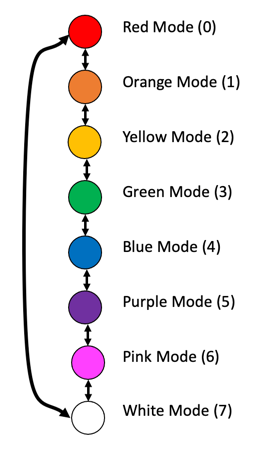1
2
3
4
5
6
7
8
9
10
11
12
13
14
15
16
17
18
19
20
21
22
23
24
25
26
27
28
29
30
31
32
33
34
35
36
37
38
39
40
41
42
43
44
45
46
47
48
49
50
51
52
53
54
55
56
57
58
59
60
61
62
63
64
65
66
67
68
69
70
71
72
73
74
75
76
77
78
79
80
81
82
83
84
85
86
87
88
89
90
91
92
93
94
95
96
97
98
99
100
101
102
103
104
105
106
107
108
109
110 | # Mode Up/Down Lab
# Change a mode using the buttons on the Maker Pi RP2040 board
# Changes the NeoPixel color and the blue GPIO status LEDs
import time
from machine import Pin, PWM
# We are using a MicroPython NeoPixel library from here: https://github.com/blaz-r/pi_pico_neopixel
from neopixel import Neopixel
BUZZER_PORT = 22
buzzer = PWM(Pin(BUZZER_PORT))
NUMBER_PIXELS = 2
STATE_MACHINE = 0
NEOPIXEL_PIN = 18
# The Neopixels on the Maker Pi RP2040 are the GRB variety, not RGB
strip = Neopixel(NUMBER_PIXELS, STATE_MACHINE, NEOPIXEL_PIN, "GRB")
# have up to 13 that we can use
blue_led_pins = [0,1,2,3,4,5,6,7,16,17,26,27,28]
number_leds = len(blue_led_pins)
led_ports = []
# create a list of the port pin object instances
for i in range(number_leds):
led_ports.append(machine.Pin(blue_led_pins[i], machine.Pin.OUT))
# Color RGB values as tuples - needs some Gamma corrections
red = (255, 0, 0)
orange = (255, 60, 0) # Gamma corrected from G=128 to be less like yellow
yellow = (255, 150, 0)
green = (0, 255, 0)
blue = (0, 0, 255)
indigo = (75, 0, 130) # purple?
violet = (138, 43, 226) # mostly pink
cyan = (0, 255, 255)
lightgreen = (100, 255, 100)
white = (128, 128, 128) # not too bright
color_names = ('red', 'orange', 'yellow', 'green', 'blue', 'indigo', 'violet', 'cyan', 'lightgreen', 'white')
num_colors = len(color_names)
colors = (red, orange, yellow, green, blue, indigo, violet, cyan, lightgreen, white)
# set to be 1 to 100 for percent brightness
strip.brightness(100)
# Sample Raspberry Pi Pico MicroPython button press example with a debounce delay value of 200ms in the interrupt handler
mode = 0 # the default mode on powerup and reset
mode_count = len(color_names)
last_time = 0 # the last time we pressed the button
builtin_led = machine.Pin(25, Pin.OUT)
# Give our pins some logical names
next_mode_pin = machine.Pin(20, machine.Pin.IN, machine.Pin.PULL_DOWN)
previous_mode_pin = machine.Pin(21, machine.Pin.IN, machine.Pin.PULL_DOWN)
# This function gets called every time the button is pressed. The parameter "pin" is not used.
def button_pressed_handler(pin):
global mode, last_time
new_time = time.ticks_ms()
# if it has been more that 1/5 of a second since the last event, we have a new event
if (new_time - last_time) > 200:
# this should be pin.id but it does not work
if '20' in str(pin):
mode +=1
else:
mode -=1
# wrap around to first mode
if mode >= mode_count: mode = 0
if mode < 0: mode = mode_count - 1
last_time = new_time
def set_blue_led_mode(mode):
global num_colors
for i in range(0, num_colors):
if i == mode:
led_ports[i].high()
else:
led_ports[i].low()
# Register the handler function when either button is pressed
next_mode_pin.irq(trigger=machine.Pin.IRQ_FALLING, handler = button_pressed_handler)
previous_mode_pin.irq(trigger=machine.Pin.IRQ_FALLING, handler = button_pressed_handler)
# Note the non-linear increases in frequency - note that some are louder
tone_freq = [100, 150, 210, 280, 350, 450, 580, 750, 850, 950, 1000]
def playtone(frequency):
buzzer.duty_u16(1000)
buzzer.freq(frequency)
def bequiet():
buzzer.duty_u16(0)
# This is for only printing when a new button press count value happens
old_mode = -1
print('found ', mode_count, ' modes.')
while True:
# only print on change in the button_presses value
if mode != old_mode:
print('new mode:', mode, color_names[mode], tone_freq[mode])
# get the color mode
color = colors[mode]
strip.set_pixel(0, color)
strip.set_pixel(1, color)
strip.show()
set_blue_led_mode(mode)
playtone(tone_freq[mode])
time.sleep(.2)
bequiet()
old_mode = mode
|
